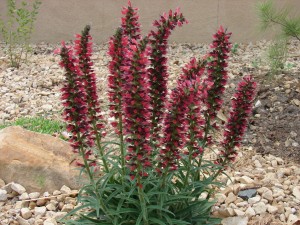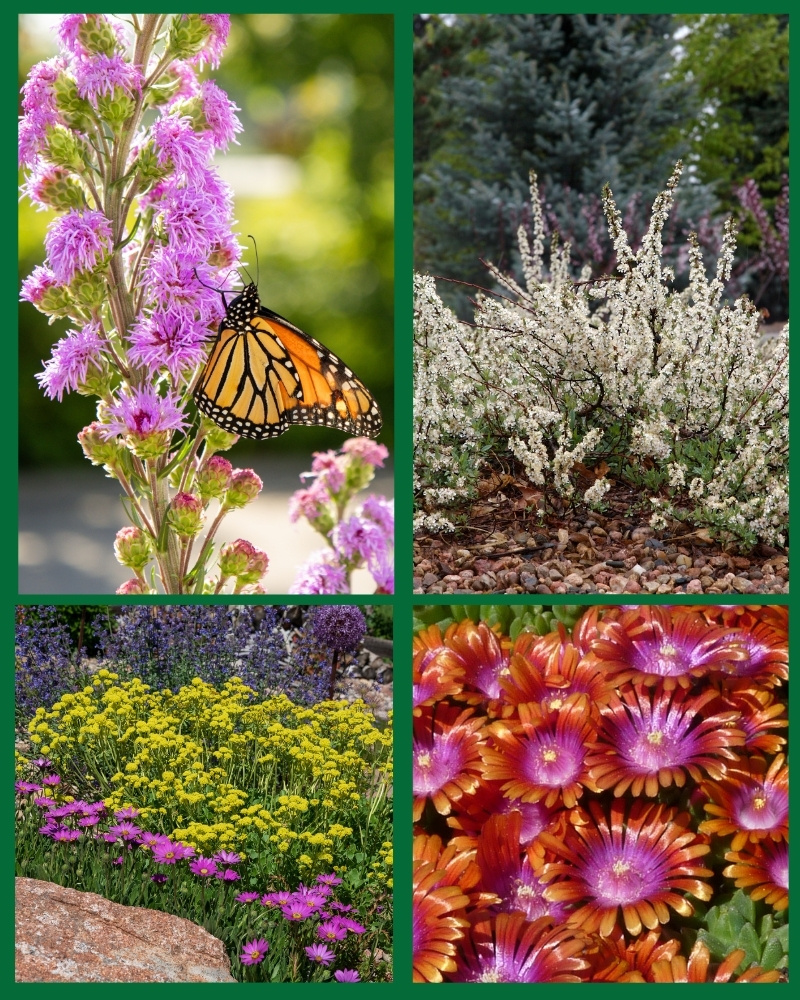Red Feathers in the Garden: Pontechium maculatum
 Red feathers (Pontechium maculatum) is one of the most interesting perennial introductions in years. It has a very structural, architectural quality to it, with straight flower spikes somewhat resembling our native Liatris punctata, but blooming much earlier in May.
Red feathers (Pontechium maculatum) is one of the most interesting perennial introductions in years. It has a very structural, architectural quality to it, with straight flower spikes somewhat resembling our native Liatris punctata, but blooming much earlier in May.
I’ve combined the unique russet-red flower spikes and growth habit of red feathers with the bright yellow flowers and low spreading habit of Genista lydia. In another garden I have it with a prickly pear cactus variety named ‘Claude Barr Plum’. It’s also a beautiful accent for other, more water loving plants, such as Purple Smoke Bush (Cotinus coggygria).
The spikes will reach a height of about 14 inches. I’ve never had any blooms lean or flop over unless the plant is actually stepped on (it happens!). It has a tuft of dark green basal foliage that only reaches about 8 inches across. It will rebloom throughout the season if the old flower spikes are removed. Red Feathers has been in one of my gardens at Legacy Ridge Golf Course in Westminster since 2006. While it doesn’t seem to be strongly perennial, it does reseed occasionally, so you may want to leave a couple of spikes of flowers/seeds to mature.
Red Feathers is from the Caucasus Mountains. It will tolerate a wide variety of conditions. I grow it in a heavy clay soil amended with sand and pea gravel. The garden is bordered on one side by a rock wall, one side by a sidewalk and the other by asphalt. Through the summer months it is watered about once a week, otherwise the clock is off and it is watered on an “as needed” basis. I grow it in full sun. It will tolerate partial shade and it will also tolerate more water. Red Feathers will be a great addition to your garden!
View the plant profile here or see the video here.
Red Feathers (Pontechium maculatum)
Perennial
Height: 12-16” inches
Width: 6-10” inches
Blooms: May to frost (if deadheaded)
Sun: Full sun or part shade
Soil Moisture: Moderate to xeric (Little to no irrigation needed once established.)
Hardiness: USDA zones 3-9
Culture: Clay, sandy soil or loam
Thanks to Shalene Hiller, City of Westminster, for writing this piece.



I love this plant. I have two, and would like more. Do seeds need to be stratified or over-wintered to germinate? Thanks!
The seeds will germinate in the same year if conditions are right. You will not need to hold them over winter. Enjoy!
Thanks very much!
They do well even in northern Ohio with loam soil and lots of rain. The only trouble is they tend to come up in a lot of places where you don’t want them. My plants have increased from about 3 to about 40 over the course of five years. Beautiful flowers.
Good to know. Thank you!
Do they bloom the first year? I bought a little box of them at a greenhouse early this spring. They are still very small.
(Western Pennsylvania)
Yes, they should if you bought them in quart size. Enjoy!
It says here to deadhead the plants, but not HOW to deadhead them. Can you please explain the appropriate way to deadhead the red feather flowers? Thank you!
Cut the flower stalks all the way down to the large foliage towards the bottom. You’ll have to wait until most if not all the little flowers are spent on the flower stalk. You could also collect the seed when they are brown and disperse the seed into another part of your garden if you’d like. Enjoy!
Is deadheading the same as pruning?
I am wondering if I cut the stalks that are brown will more stalks grow in its place throughout the summer?
Yes, for the most part. Pruning usually implies a focus on plant structure while deadheading is just pruning off the spent flowers so more flowers will bloom. Preventing flowers from going to seed can “trick” those plants into producing more flowers. Enjoy!
Hey Ross!
I planted two Red Feathers that I picked up at the flower bin in Longmont, and they seem to look a little off. They grew massively high, and have not shown any color yet. See below, any thoughts??
Great to hear from you Andrew! Glad to know you’re buying more PS plants! Send photos to director@plantselect.org I’m guessing that there is not enough light in the back corner there, so it grew high and did not bloom properly. It could also be being eaten by grasshoppers if you have a lot of them. They’ll strip it down to the stem.
I have two plants in Palmer Alaska Zone 3. They are not commonly sold and I found mine at a greenhouse in Homer. They looked interesting and I’m always looking for something out of the ordinary in perennials. I’ve had them about 4-5 years now and they always come back. But this year, am moving them to a different location so we’ll see. The comments here are very helpful as well.
Mine seem to be highly perennial. I’ve had one plant for five years, with many “children” now all around it.
It is the end of August, my friend brought me Echium, red feather, she said it has not bloomed, I would like
to collect seeds from it, it is not fringe looking up the stalks it has solid little nodules on it, one stalk
has a few red blossoms on it, how can I tell if it has gone to seed.
Thank you. Bonnie
When the flower stalks dry out, they will turn dark brown or almost black. There will be seeds throughout those stalks. Stripe off spent flowers onto the ground and press them into the soil with your shoe or bucket. They will come up the following year.
Hello. I purchased two of your plants from a nursery and instructions on how to heal them, see picture.
I planted 2 of them in full sun and the conditions are quite hot right now, with afternoon sun. I am in CO. The red feathers turned dark and sad looking. I have them back in the pots on partial sun hopping they will recover. I water them every other day. I used rose soil but CO is more like clay and very dry. What else can I do to help them recorer?
Thank you very much
Keep them on the dryer side and in full sun. Trim them back and see if they rejuvenate.
Your discussion and the other contributors’ comments have been so helpful. I’m in love with my two young red feather plants. The thought that I can yield new plants from deadheaded blooms is a prospect that is fascinates me. My concern that I maybe overwatering my young plants. I water the plants once a day (evening), they do wilt in the heat where I’ve planted them. What are the specific similarities between Denver and the Caucasus Mountains that allow plants in both regions to flourish?
Watering once per day is too much and or too often. Caucasus Mountains region receive about the same natural precipitation as our region. Once per week (at most) watering will be perfect for these plants to thrive and look their best.
I’d like to send two photos of my Red Feather plants—one plant is doing well and the second, is having problems. Both plants have been treated just the same related to watering and are planted in the same row of my garden.
Send photos to Director@plantselect.org
I can only send one I sent the bad one last time. This is the one that is doing well. Both in the same garden area, with the same watering pattern
I recently planted these plants because they have fuzzy leaves so I am hoping they are deer resistant. Any experience with this resistance?
Thanks
These should be deer resistant for you. They also make great cut flowers.
I have 2 of these, only in their second season. Both bloomed last year and one is on the verge of, however, the other is lush with foliage but no blooms. Should this plant then be divided or has it run its course? Thank you~D
Leave them both, the lush one may bloom next year. Be sure to collect and spread the seed around after they bloom to ensure there will be more in coming years.
My red feathers receive no supplemental water at 5900′ in semi-arid Colorado. They bloom and reseed. They receive compliments even before flowering.
I got one last year on the clearance rack with no name tag. I just found out what it was. I am giving mine too much water and it is huge and falling over. I also just took a cutting to see if I could root one. 🙂